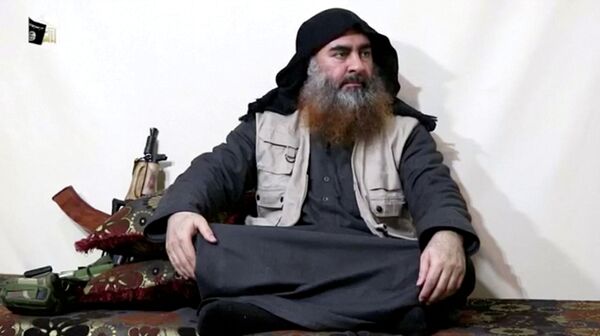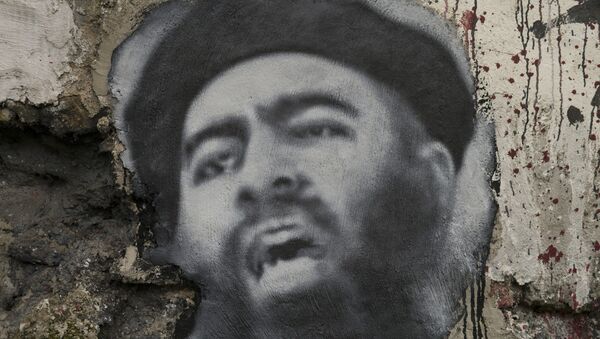A man thought to be Abu Bakr al-Baghdadi, the shadowy Daesh leader and former self-styled “caliph”, died during an overnight US-led raid.
His demise was first reported by Newsweek, which cited a senior Pentagon source as saying that al-Baghdadi presumably killed himself by detonating a suicide vest in Barisha village in Idlib, a province in northwestern Syria.
A US official separately told the Associated Press on condition of anonymity late Saturday that al-Baghdadi was targeted in Idlib province.
An Iraqi intelligence source also confirmed the news, saying that Iraq played a “significant role” in the elimination of al-Baghdadi. Iraqi intelligence agencies allegedly provided exact coordinates of al-Baghdadi's location to the US-led coalition in Syria.
The Daesh chief arrived at Barisha some 48 hours before the operation, a senior Turkish official said. US helicopters have reportedly dropped fighters in Idlib before fighting broke out with the jihadists.
US President Donald Trump cryptically tweeted on Saturday night: “Something very big has just happened!” He is expected to make a “major announcement” today at 9 a.m. EST (1300 GMT), which will likely shed more light on what happened in Syria.
Any similar speculation in the past?
Al-Baghdadi, just like Osama bin Laden, has been reported to have died or injured in raids multiple times.
A report in 2015 claimed he was bedridden after a US strike. Multiple accounts alleged throughout the summer of 2017 that he was either arrested or killed, but neither has been corroborated.
Who is Mr. Baghdadi?
The scarce details of al-Baghdadi’s biography mostly come from jihadist websites and statements.
According to a jihadist biography penned by an unidentified author and dated 2013, his full given name was “Ibrahim bin Awwad bin Ibrahim al-Badri al-Radhwi al-Husseini al-Samarrai” (Al-Baghdadi simply means “from Baghdad” in Arabic).
It is understood that he was born in 1971 in Samarra, Iraq (over 100km north of Baghdad) and went to the Islamic University in Baghdad, where he earned a bachelor’s degree in Islamic studies.
How did he come to power?
Al-Baghdadi reportedly preached at a Baghdad mosque before joining the insurgency sparked by the US-led invasion of Iraq in 2003. That same year, along with some associates, he created Jamaat Jaysh Ahl al-Sunnah wa-l-Jamaah, a militant Sunni group that operated in Samarra, Diyala and Baghdad.
He is widely believed to have been arrested in 2004 in the insurgency hotbed of Falluja and was placed in an American prison (there is a widely-publicised mugshot of his from Camp Bucca), but the date of his release is still disputed and put between 2004 and 2009.

His group pledged allegiance to the Mujahideen Shura Council, an umbrella organisation of several anti-US Sunni Islamic insurgent groups, which changed its name to the Islamic State of Iraq (ISI) in 2006. Al-Qaeda’s branch in Iraq was also part of the ISI.
Al-Baghdadi took over as the new ISI leader in May 2010, after the death of his predecessor Abu Umar al-Baghdadi. The group wasn’t known to control any territory in Iraq at that time. ISI soon managed to capitalise on the chaos of the civil war in Syria, where they formed an offshoot known as the al-Nusra Front.
The ISI leader soon had a fall-out with the leader of al-Nusra, Abu Mohammed al-Julani, over their goals in Syria, and announced a merger with al-Nusra in April 2013 under the name “the Islamic State of Iraq and al-Sham”, commonly abbreviated as ISIS and also known by its Arabic-language acronym Daesh.
Al-Julani, however, publicly swore loyalty to al-Zawahiri, the head of al-Qaeda’s central command, who ordered that ISI and al-Nusra operate as separate entities. Al-Baghdadi defied the instructions, leading to a split from al-Qaeda and to clashes with Nusra.

Daesh made international headlines in 2014, after it launched an offensive on the Iraqi cities of Mosul and Tikrit and in northern Syria. Al-Baghdadi first appeared in public at the ancient Nuri mosque in Mosul in June that year, when he declared himself as the caliph of a new “Islamic State.”
The Daesh leader had been keeping a low profile since his Mosul speech. His self-styled caliphate, despite having its own short-lived army and currency, fell as fast as it rose in fights with local militias as well as Syrian and Iraqi government forces, aided by Russia and Western nations.
Daesh released several audio-taped messages purported to be from Baghdadi between 2014 and 2018. In April this year, a man with his appearance was shown sitting next to an assault rifle and addressing the loss of Baghouz by Daesh and discussing some contemporary events, including the Sri Lanka Easter bombings and protests in Sudan and Algeria. The following month, al-Baghdadi was speculated to be hiding in Afghanistan, but those reports were never confirmed.




